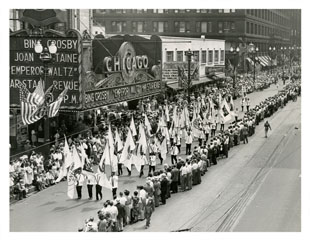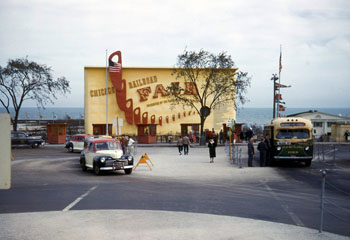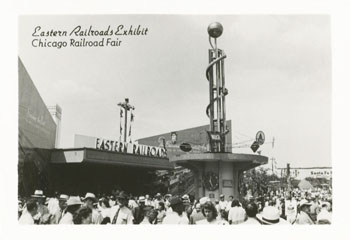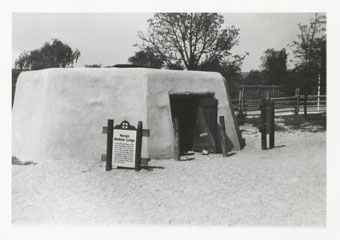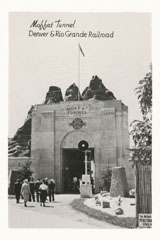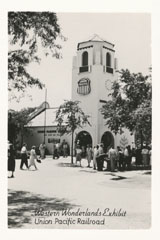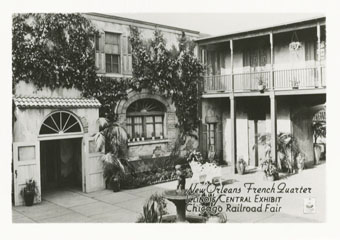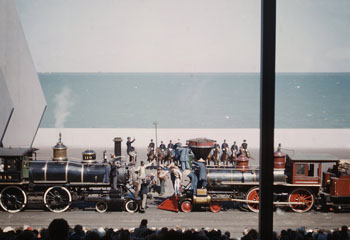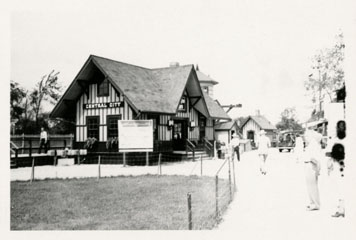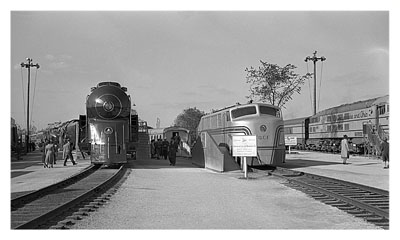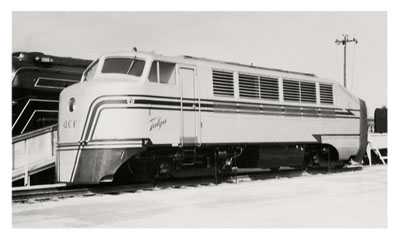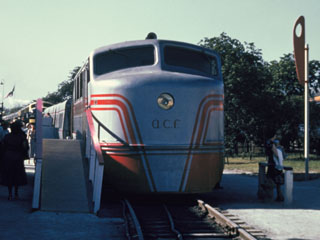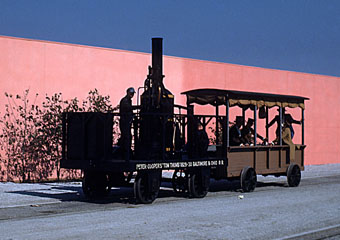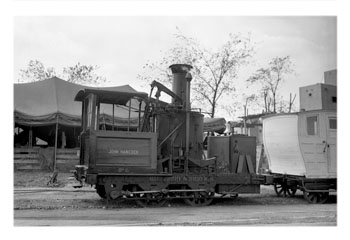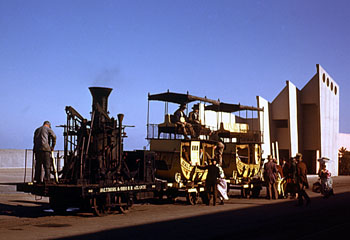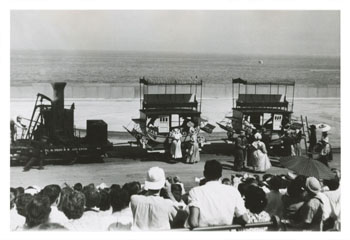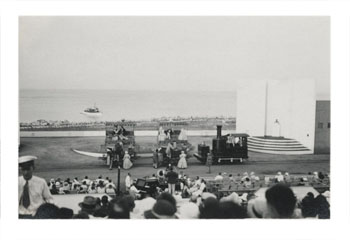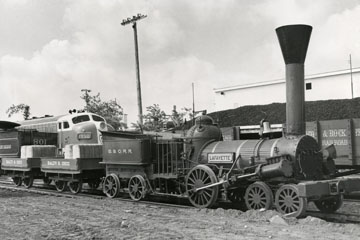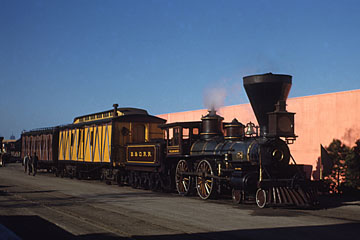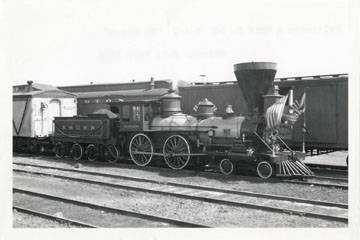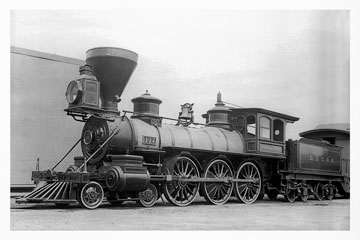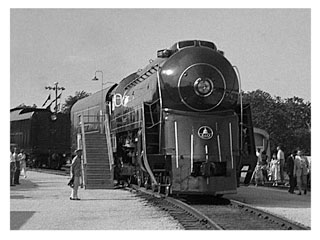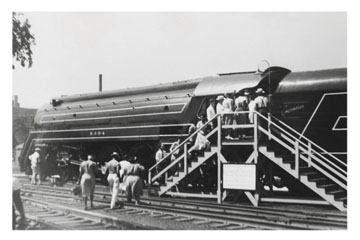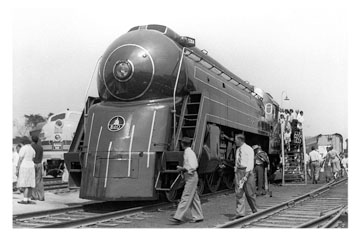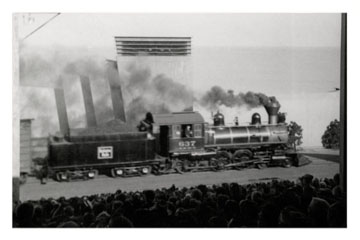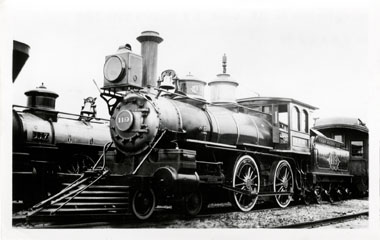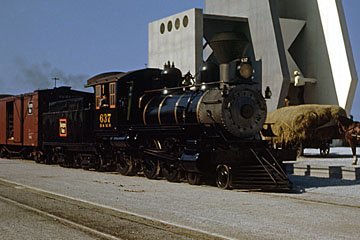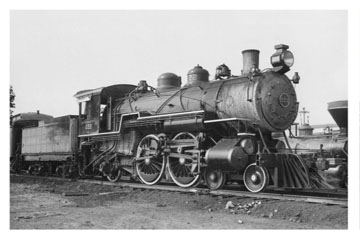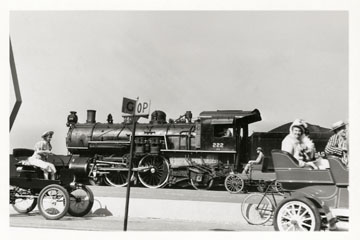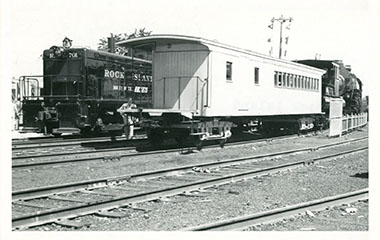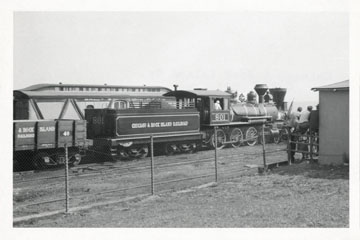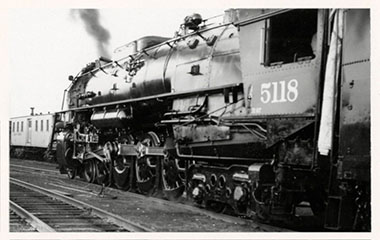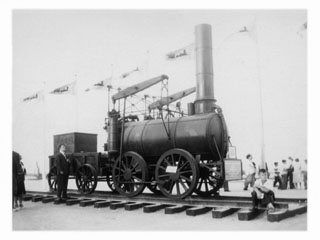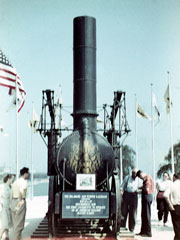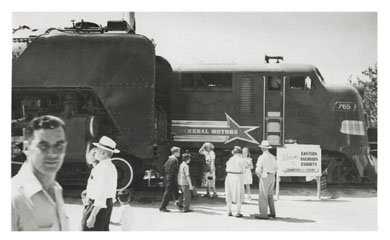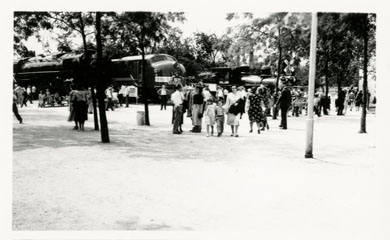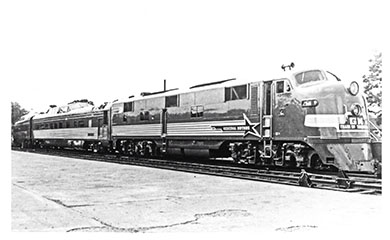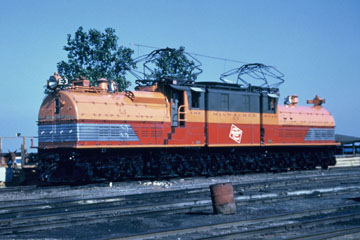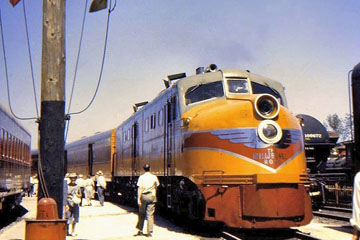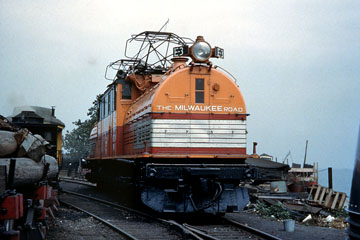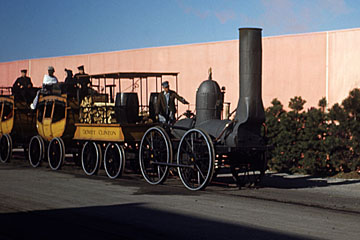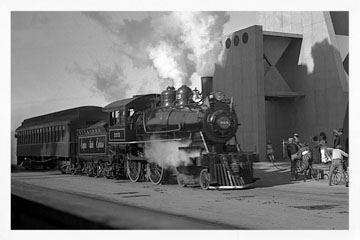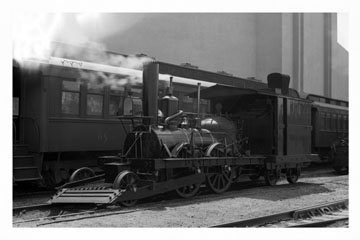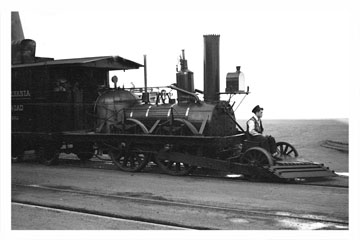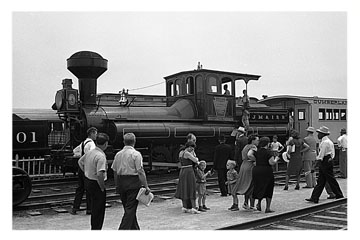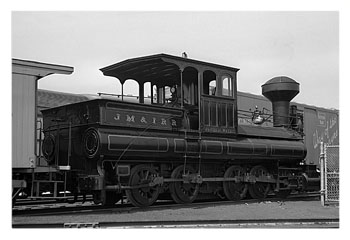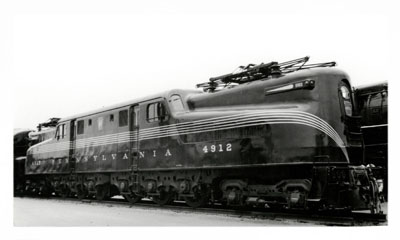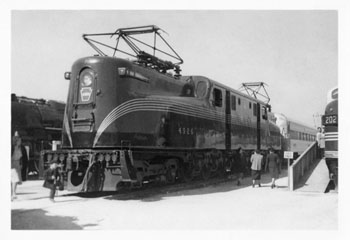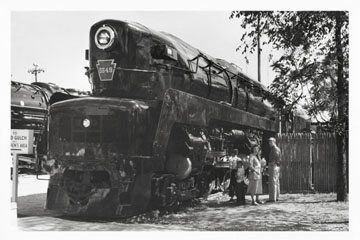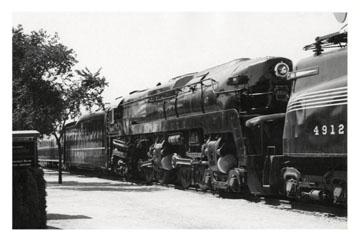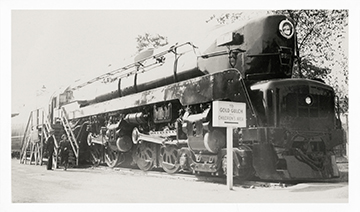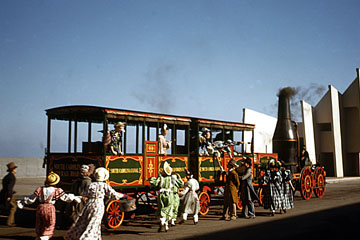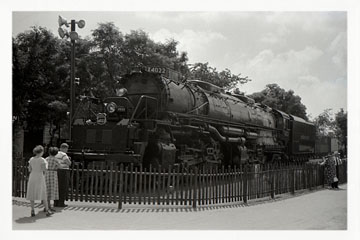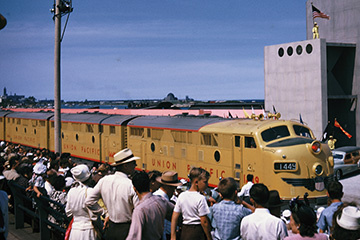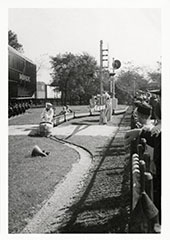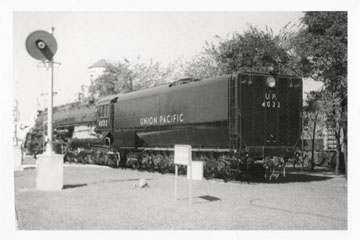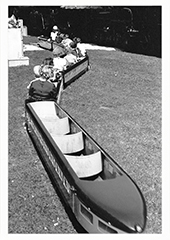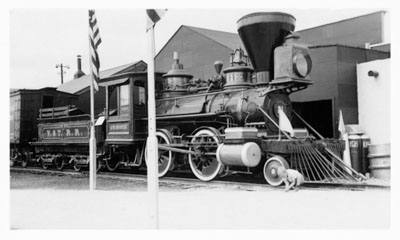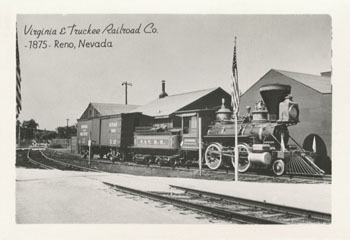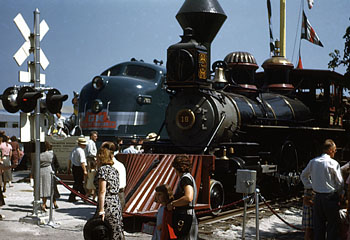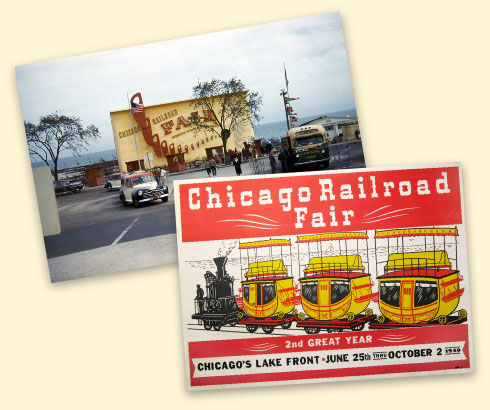

The Chicago Railroad Fair was apparently the brainchild of Chicago & North Western Railway Public Relations Manager Frank Koval, and was intended to commemorate one hundred years of railroading in Chicago. This was particularly pertinent to the C&NW as it was the successor to the first railroad to operate out of Chicago, the Galena & Chicago Union Railroad and still had the locomotive, the "Pioneer", that hauled the first train westbound out of the city on 25th October 1848.
Planning took place during the winter and spring of 1948, and the fair was constructed on fifty acres of Burnham Park between 21st and 31st Streets, on a section of the park that had hosted the Chicago World’s Fair in 1933-34. Thirty-eight railroad companies participated in what was the last great national assembly of railroad equipment and technology, with a veritable who's-who of Class I railroad executives on the Board of Directors led by the Lenox R. Lohr, President of the Museum of Science and Industry in Chicago. More than twenty other equipment manufacturers also participated, including General Motors, the Budd Company, the Pullman Company and the Timken Company.

Admission to the fair was $1 and, except for food, all the attractions, displays, exhibits and shows were free. There were two and a half miles of railroad, and at least eighteen locomotives operated under their own power during the "Wheels a-Rolling" pageant. Thirty additional locomotives and pieces of equipment were part of the general exhibition.
Below, members of the brotherhood of Sleeping car Porters parading with the flags of their different railroads.
The fair opened on 20th July 1948 and ran until Labor Day. It was preceded by a parade starting at 1:30 pm in Grant Park travelling up Jackson Blvd to State St then north to Wacker Drive, featuring model locomotives running on rubber tyres, a marching band and a contingent of cowboys and Native Americans.
The octogenarian widow of Casey Jones rode in an automobile at the head of the parade and served as honorary Grand Master of the parade.
The fair attracted over five and a half million visitors over its two years, but it was mounted as the industry was entering a period of change and decline.
Diesels were fast replacing steam locomotives: in 1948, the year the fair opened, Alco built its last steam locomotive and, the following year, both Baldwin and Lima built their last. By 1950, passenger traffic was steadily dropping and abandonments, which had begun during the 1930s recession, continued. Heavy regulation from the ICC led to a lack of investments and the bankruptcy of several companies.
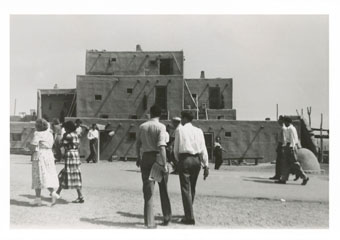
Above, the Santa Fe set up an "Indian Village" in the fair.
One hundred and twenty-five men, women and children from the Navajo, Hopi, Jemez, Zuni, Laguna and Apache tribes lived in the specially constructed village. According to the official guidebook, "[t]he colorful village gives you the scenic rewards of weeks of travel through the fabulous Indian country" with the villagers entertaining visitors "staging legendary dances, singing age-old Indian songs in strange Indian tongues".
Other exhibits included, above and right, Florida in Chicago with a 25' scale replica of the Bok singing tower, Gold Gulch, Frontier Town of Gold Rush Days, a replica of the portal of the Moffat Tunnel, movies, miniatures, models, dioramas and animated figures representing the Western Wonderland, a street scene from the New Orleans French Quarter and a 35' tall robot of Paul Bunyan.
At different times, the fair included a rodeo and ranch with a functioning replica of the Old Faithful geyser, live bears and other displays, square dancing in a village hall, the Cypress Gardens Water Thrill Show and an an outdoor ice skating show.


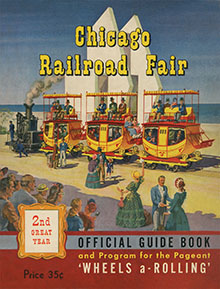
Above, the 1948 and 1949 programs for the "Wheels a-Rolling" pageant.
The seventy-five minute long show comprised a prologue, twelve scenes and an epilogue. It ran four times daily and ended with an elaborate fireworks display over Lake Michigan.
It is credited as being “adapted from a pageant play” by Edward Hungerford, and staged and directed by Helen Tieken Geraghty, both of whom had experience of similar enterprises.
Hungerford was director of the 1927 Fair of the Iron Horse, the “Wings of a Century” pageant at the 1933-34 Chicago World’s Fair and provided words for the “Railroads on Parade” pageant at the 1939-40 New York World’s Fair. For her part, Geraghty had staged and directed the “Wings of a Century” pageant at the 1933-34 Chicago World’s Fair.
Above, the entrance to the "Wheels a-Rolling" pageant, which was the highlight of the Fair. A dramatic and musical presentation on a 450’ long stage, it featured eighteen locomotives in steam and two hundred and twenty performers with eighteen different period costumes and was intended to showcase the development of transportation and the railroads across the country beginning with trails and waterways.
Amongst the twelve scenes, the pageant included a recreation of the historic race between the horse drawn carriage and “Tom Thumb”, a re-enactment of the Golden Spike ceremony at Promontory, Utah, and the high speed drive by of New York Central #999.

Below, in 1949, another engine joined the "Deadwood Central" roster. Built for the Denver & Rio Grande Railroad in 1882 as #6002 by Burnham, Parry, Williams & Co., it became Class 16 #268 in 1924. In 1949, it was the D&RGW’s oldest operational narrow gauge locomotive and was painted in “Grande Gold” (also known as the “Bumble Bee” scheme) as Cripple Creek & Tin Cup Railroad #268 for the fair.
It was returned to the D&RGW in 1950. Three years later, it starred in the Paramount Pictures movie The Denver & Rio Grande.
Above, Central City station on the "Deadwood Central". This narrow gauge railroad carried passengers the length of the fifty acre site between the main entrance at 23rd Street and Gold Gulch, the fair's Western town. The cost to ride the train was one dime.
The buildings and rolling stock were from the original Deadwood Central Railroad, including the private car once used by President Ulysses S. Grant, Diamond Jim Brady and other celebrities. The railroad was founded in 1888 and operated between Deadwood, SD, and Central City, CO.
Above in 1948, the "Deadwood Central" was
hauled by a locomotive built by the Cooke Locomotive Works in Paterson, NJ, in 1884 as #72 for the Denver, South Park & Pacific Railroad. It was renumbered #114 in 1885, became Denver, Leadville & Gunnison #114 in 1889 and Colorado
& Southern # 9 in 1899. It hauled the last
passenger train from Leadville to Denver on 10th April 1937.
#9 hauled a six car consist on the “Deadwood Central”, retaining its original #9 but dubbed "Chief Crazy Horse". #9 had also appeared at the 1939-40 Chicago World’s Fair. It is now on display in Breckinridge, CO, and you find out more about it on the CS #9 page of this website.
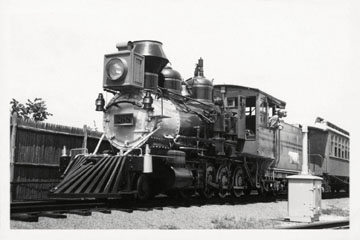
You can find out more about #268 on the DRG #268 page of this website.

The three US-built Talgos entered service on the Rock Island Line, servicing the Jet Rocket train, between Chicago and Peoria, IL. One was also trialed on the New York Central, and they were also built for the New York, New Haven & Hartford Railroad and the Boston & Maine for its Speed Merchant train, running between Boston, MA, and Portland, ME.
Despite the publicity, they were not a great success and no American railroad expressed interest in ordering Talgos.
Above, the Talgo, one of three articulated units built by the American Car & Foundry Company in St. Charles, MO, under the direction of Spanish engineers with electrical components made by General Electric. Talgo stands for “Tren Articulado Ligero Goicoechea Oriol” which means “lightweight, articulated train by Goicoechea and Oriol”.
The Talgo company was formed in Spain in 1942 by Alejandro Goicoechea and José Luis Oriol. The company was headquartered in Las Rozas de Madrid and the Talgo I, built as a prototype was outshopped the same year. The Talgo coaches were built at the "Hijos de Juan Garay" workshop in Oñati and the locomotive was built at the workshops of the "Compañia de Norte" in Valladolid.

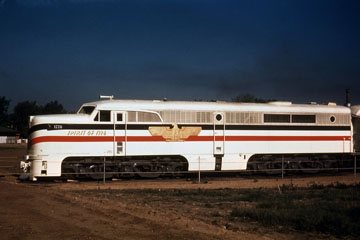
Above, Alco PA-1 #1776, which headed up the American Freedom Train, shown standing in the yard in Denver CO.
This locomotive hauled the Freedom Train on its 37,000 mile nationwide tour from 17th September 1947 to 22nd January 1949. The first locomotive to operate in all forty eight states, it was loaned for its historic tour by its manufacturers, Alco and the General Electric Company. Named "Spirit of 1776", the locomotive was painted to the specifications of designer Chester Mack.
Alco outshopped two models of the PA units, the 2,000 hp PA-1/PB-1 built between 1946 and 1950, and the 2,250 hp PA-2/PB-2 built between 1950 and 1953. On the PA-1s, an Alco 244 V-16 4 cycle prime mover powered a GE GT566C1 generator to drive four GE 746A2 traction motors. The PA-1 units were 65’ 8” long and weighed 306,000 lbs. With starting tractive effort of 50,865 lbs at 25% and continuous tractive effort of 30,500 lbs at 20 mph, they had a top speed of 117 mph.
The train was at the fair from 5th-9th July 1949. After the tour, #1776 went into service on the Gulf, Mobile & Ohio Railroad renumbered #292. While on the GM&O, it carried a pair of large bronze plaques noting its service on the Freedom Train. It has not survived.

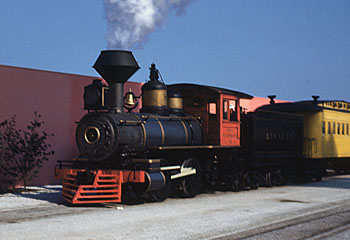
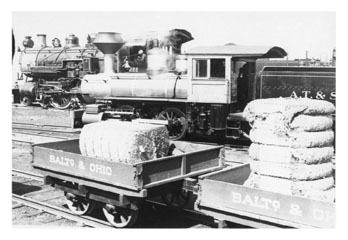
Above, Atcheson, Topeka & Santa Fe Railroad #5, an 0-4-0, was built in 1899 by Burnham, Williams & Co., an early incarnation of the Baldwin Locomotive Works in Philadelphia, PA, as AT&SF saddle tank #2419.
It was rebuilt with a tender to take part in the fair in 1948, at which time it was named "Little Buttercup" after a character in the Gilbert and Sullivan operetta, HMS Pinafore. It appeared in the 1951 Columbia Pictures movie Santa Fe starring Randolph Scott.
#5 has been preserved at the Kelly Park History Park in San Jose, CA.
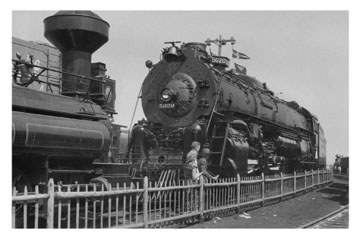
Above, #5020 is one of twenty-five Class 5011 Texas type (2-10-4) locomotives built for the Santa Fe in 1944 by the Baldwin Locomotive Works (#5011-#5036). They were the last steam locomotives delivered to the railroad and one of the largest non-articulated locomotives ever built. At 74", the driving wheels were also the largest ever applied to a Texas type, and the 310 psi boiler pressure one of the highest.
Designed to haul heavy freight at speeds approaching 70 mph, they were also used to meet the demands of increased passenger troop trains during the final years of WWII. Features included Timken roller bearings fitted to all axles, including the tender trucks, Worthington 6SA feedwater heaters, cast-steel beds with integral cylinders and lightweight rods. Despite a comparatively small firebox for their size, they were great steamers and much liked by crews for their smooth handling. Most were retired in 1950, but a few saw service as late as 1957. Finally, in 1959, all but four set aside for preservation were scrapped.
You can see photos of three of the survivors and find out more about the class on the National Museum of Transportation, St. Louis Train Shed page of this website, the National Railroad Museum page and the ATSF 5030 page.
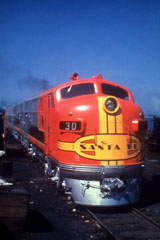
Above, AT&SF EMD F3 #30.
The F3 was the third in EMD's F series. Designed to haul freight, they were the most successful "first generation" diesel locomotives in North America, largely responsible for replacing the steam locomotive in road freight service.
The Santa Fe took delivery of a total of forty-six F3 A units and forty-six F3 B units in 1948.
#30 has not survived, but twelve of the units have. You can see DLW F3 #663 and F3 #664, originally BA #44 and #46, on the Scranton Yard page of this website.
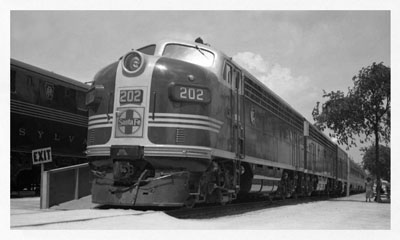

Above, AT&SF EMD F7 #202 appeared at the fair in 1949, as well as #211. The fourth in EMD's line of F-unit locomotives, the F7 was the best-selling cab unit of all time. Two thousand, three hundred and sixty-six F7 A units and one thousand, four hundred and eighty-three cabless B units were built between 1949 and 1953 by EMD and its Canadian subsidiary, GMD. #202 was built in June 1949, the first of a batch of ten (#202-#211) delivered to the Santa Fe that year.
#202 was retired on 1973, and rebuilt at the AT&SF's Cleburne, TX, works as CF7 #2571. It was sold to Los Angeles Junction Railway in 1984, and joined the collection of the Oklahoma Railroad Museum in Oklahoma City, OK, in 2014.

This replica of the "Pioneer" was built at the
Baltimore & Ohio Railroad's Mt. Clare workshops in 1892 for display at the 1893 World's Columbian Exposition in Chicago, IL. The original was built by Richard Imlay and carried the B&O company directors on their trip from Mt. Clare to Ellicott's Mills on 22nd May 1830.
The replica was also displayed at the 1927 Fair of the Iron Horse, the 1933-34 Chicago World's Fair and the 1939-40 New York World’s Fair. You can find out more about it on the B&O Railroad Museum Roundhouse page of this website.
This 0-4-0, the "Tom Thumb", is a replica built at Baltimore & Ohio's Mt. Clare workshops in 1927 for the Fair of the Iron Horse in Halethorpe, MD. The original was built in 1830 by inventor and businessman Peter Cooper as a demonstrator locomotive. On 28th August 1830, it carried the B&O directors in a passenger car to Ellicott's Mills, travelling at the then impressive speed of 10-14 mph.
The replica was also displayed at the 1933-34 Chicago World's Fair and the 1939-40 New York World’s Fair. You can see photos and find out more about the “Tom Thumb” on the Baltimore & Ohio Railroad Museum Roundhouse page of this website.
This locomotive started life as the "John Hancock", built by George Gillingham and Ross Winans in 1836. It was retired and rebuilt for the 1893 World's Columbian Exposition in Chicago, IL. At that time, it was incorrectly named the "Thomas Jefferson", which had been the railroad’s first "Grasshopper" locomotive #3.
The engine was displayed at the 1927 Fair of the Iron Horse, the 1933-34 Chicago World's Fair and the 1939-40 New York World's Fair. You can find out more about it on the B&O Railroad Museum Roundhouse page of this website.
This engine, appearing as the "Atlantic" is actually the "Andrew Jackson" #7, built in 1836, which was adapted in 1892 to resemble
"Atlantic" #2 for the 1893 Columbian Exposition in Chicago, IL. The original "Atlantic" was built in 1832 by Phineas Davis and Israel Gartner of York, PA, , after winning the competition to design a suitable locomotive for the line, but was scrapped in 1835.
This version of the “Atlantic” was also displayed at the 1927 Fair of the Iron Horse, the 1933-34 Chicago World's Fair and the 1939-40 New York World’s Fair. You can see photos and find out more about it on the Baltimore & Ohio Railroad Museum Roundhouse page of this website.
This replica of the 4-2-0 "Lafayette" was built at the Baltimore & Ohio's Mt. Clare workshops in 1927 for the Fair of the Iron Horse where it was displayed as the "William Galloway". It was the first horizontal boilered locomotive built for the railroad and the first commercially produced with a swivelling four wheel pilot truck.
The locomotive appeared as the “William Galloway” at the 1933-34 Chicago World's Fair and the 1939-40 New York World’s Fair. By the time it appeared at the Chicago Railroad Fair, it had returned to the name “Lafayette”.
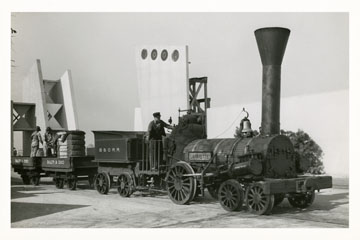
The "Lafayette" is on the B&O Railroad Museum Roundhouse page of this website.
This American type (4-4-0) wood burning locomotive was built by the Mason Machine
Works in Taunton, MA, in 1856 as #25. Renumbered #55 in 1882, it returned to #25 in 1892 and was named "William Mason" in 1927 in honour of its builder when it appeared at the Fair of the Iron Horse.
#25 was also displayed at the 1933-34 Chicago World's Fair and the 1939-40 New York World’s Fair. The "William Mason" is the oldest operating steam locomotive in the US and has had a long career, appearing in many movies. You can see photos and find out more about the “William Mason” on the Baltimore & Ohio Railroad Museum Roundhouse page of this website.
#117 is a Ten Wheeler (4-6-0) type locomotive built at B&O's Mt. Clare shops in 1863 to meet increased demand arising from the Civil War. It was one of eleven Ten Wheeler type locomotives designed by B&O Master of Machinery, Thatcher Perkins, originally numbered #147. It was renumbered #117 in 1892 for the 1893 Columbian Exposition held in Chicago, IL.
#117 was also displayed at the 1927 Fair of the Iron Horse, the 1933-34 Chicago World's Fair and the 1939-40 New York World’s Fair, but has since been returned to its original number.
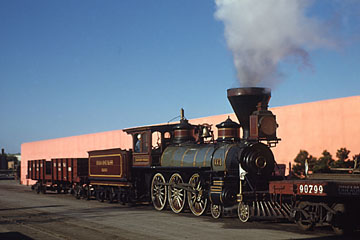
#117 is on the B&O Railroad Museum Roundhouse page of this website.
Top photo, #5302 was one of twenty P-7 Class Pacific type (4-6-2) locomotives built by Baldwin in 1927 (#5300-#5319). They were named after the first twenty US presidents. #5301-#5304 were streamlined to a design by Otto Kuhler for the prestigious B&O Royal Blue in 1937 and reclassed as P7d. #5302, “President Jefferson”, replaced #5304, shown right, at the fair in 1949.
Neither #5302 nor #5304 has survived. However,
Below, #5304 “President Monroe” also appeared at the fair in the first year, 1948.
The P7d class weighs 326,000 lbs, 205,000 lbs on its 74" drivers with an engine wheelbase of 37' 8" and driver wheelbase of 14'. The 70.8 sq ft grate, 394 sq ft firebox with 81 sq ft of thermic syphons and 14 sq ft of arch tubes gives a total heating surface of 3,846 sq ft, including 932 sq ft superheating. It operated at boiler pressure of 230 psi delivering 49,882 lbs tractive effort. The 218,000 lb tender has an 11,000 gallon water and 17½ ton coal capacity.
Although the streamlining was removed in 1940, it was reinstated in 1946 when the four locomotives were assigned to the shortlived Cincinnatian running between Baltimore, MD, and Cincinnati, OH (in 1950, the route was cut back to Detroit, MI, to Cincinnati, OH). The P7d was the only class of steam locomotive streamlined by the B&O.
Despite claims to the contrary, streamlining was more for advertising than improved speed and efficiency. It was one manifestation of the late phase of the Art Deco design aesthetic of the 1920s and 1930s.
Nor was streamlining particularly widespread. Of the c.5,000 locomotives built in the the US in the 1920s, heyday of the Art Deco movement, only 220 were streamlined.
Kuhler designed four locomotives in 1934 for the Milwaukee Road Hiawatha service, including all the interiors down to napkins and draperies.
You can see the first “President”, #5300 the "President Washington" and find out more about the class on the Baltimore & Ohio Railroad Museum Yard & Shops page of this website.
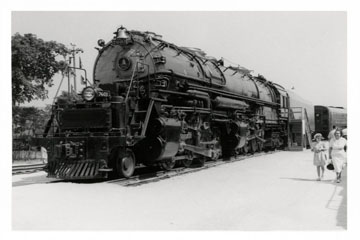
Above, #7603 was one of thirty Yellowstone type (2-8-8-4) Class EM-1 locomotives built for the Baltimore & Ohio Railroad (#7600-#7629). They were outshopped by the Baldwin Locomotive Works in Philadelphia, PA, in 1944 (#7600-#7619) and 1945 (#7620-#7629).
The EM-1 had a 65’ 2” engine wheelbase and a
16’ 6” driver wheelbase, with Walschaert valve
gear and four 24” x 32” cylinders. The engine weighed 628,700 lbs, 485,000 lbs on its 64”
drivers. With a 175.5 sq ft grate, the 756 sq ft firebox heating surface included 211 sq ft of thermic syphons and arch tubes. Total heating surface was 7,416 sq ft, including 2,118 sq ft superheating. Operating at a boiler pressure of
235 psi, they delivered 115,056 lbs tractive effort. The tender weighed 382,000 lbs and had a
capacity of 22,000 gallons of water and 25 tons of coal.
Every engine and tender axle was fitted with roller bearings. Lateral cushioning devices on each lead driver axle eased the locomotive into curves, and the lead axle in the trailing truck was also cushioned in this way.
Scrapping of the locomotives started in 1957, and all were off the roster by 1960. None of the EM-1 class locomotives has survived.

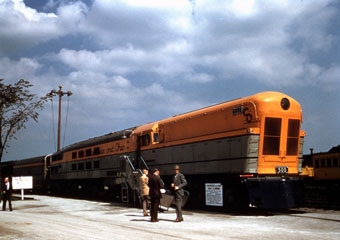

The Chesapeake & Ohio created a fleet of three Class M-1 steam turbine locomotives in collaboration with Baldwin and Westinghouse in 1947-1948 at a cost of over $500,000 each. They were intended for service on the Chessie streamliner, planned to run between Washington, DC, and Cincinnati, OH. #501 appeared at the fair in 1949. At 154’ ¾”, at that time, the M-1 was the longest single unit locomotive in the world. The engine weighed 857,000 lbs.
Pulverised coal was fed to a water tube firebox by an automatic stoker, and over fire air caused complete combustion with no smoke.

The 500s were touted as requiring less maintenance than a conventional steam locomotive, but they were expensive to run, mechanically unreliable, and never made the Washington to Cincinnati run without breaking down. The main problems were coal dust fouling the forward traction motors and water dripping from the boiler short circuiting the traction motors on the powered trucks.
The C&O cancelled the Chessie in 1948, before it even ran in revenue service. The M-1s were confined to operating between Clifton Forge and Charlottesville, VA, and were scrapped in 1950.

This Ten Wheeler (4-6-0) CBQ Class K-2
locomotive was built in 1892 by the Rogers Locomotive & Machine Works in Paterson, NJ, as Burlington & Missouri River Railroad #309. The B&MRR was incorporated in Burlington, IA, in 1852 and started operations in 1856. In 1904 when it was merged into the Burlington, #309 was renumbered #637. It was fitted with a diamond stack for exhibition at the fair.
#637 has been preserved, and you can see photos and find out more about it on the Illinois Railway Museum Train Shed page of this website.
#35 is an American type (4-4-0) locomotive built at
the Burlington’s Aurora, IL, shops in 1892 as
Hannibal & St. Joseph #66. In 1898, it was
renumbered #666 and then became CB&Q #359 when the H&StJ was incorporated into the CBQ in 1904. It was rebuilt in Denver, CO, in 1932 for the 1933-34 Chicago World's Fair as Burlington & Missouri River #35. It also appeared at the 1939-1940 New York World’s Fair, standing in for Union Pacific #119 at the re-enactment of the Golden Spike ceremony, as it does here.
#35 has been preserved and is on display at the
Patee House Museum in St. Joseph, MO. You can find out more about it on the CBQ #35 page of this website.
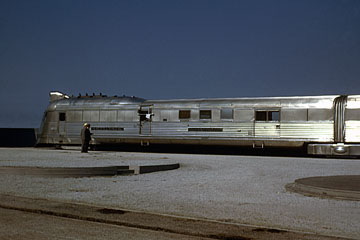
Above, the Burlington "Pioneer Zephyr" appeared at the fair in 1949. It had been built in 1934 and
was the first of what would become one of the largest and most famous fleets of streamliners in the US. It first appeared at the Chicago World's Fair in 1934.
Named by Burlington’s President Ralph Budd after Zephyrus, Greek god of the west wind, it was built by the Budd Company in Philadelphia, PA, entirely of welded stainless steel. Aeronautical engineer Albert Gardner Dean designed the sloping nose, with architect John Harbeson and industrial designer Paul Philippe Cret devising a way to strengthen and beautify the sides of the train with its distinctive horizontal fluting.
Zephyr was equipped with an 8-cylinder, 8-201-A model Winton engine developing 600 hp at 750 rpm. Its four cars rode on four roller-bearing trucks, forming a permanently articulated 197' long trainset weighing 193,000 lbs.
#9900's last revenue run was on 20th March 1960 from Lincoln, NE, to Galesburg, IL. On 26th May 1960, it was presented to the Museum of Science and Industry in Chicago, IL, having run 3,222,898 miles in service. You can see photos and find out more about it on the Museum of Science and Industry page of this website.
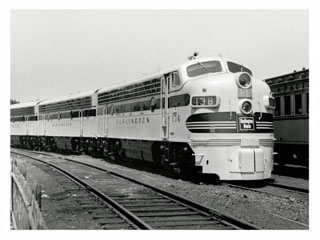
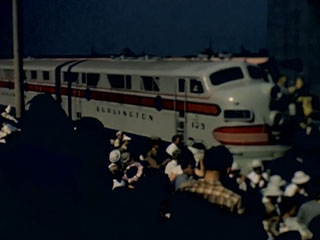
Top, CB&Q EMD F3 #138 and, middle, CB&Q EMD F3 #129 were both built in 1948. In addition to the A unit, with cab, they were coupled to three cabless units (B, C & D). At the time, these were amongst the most modern of the Burlington's freight hauling fleet. The railroad bought fifty-eight F3 units between 1947 and 1949. EMD built a total of one thousand, one hundred and eleven A units and six hundred and ninety-six cabless booster units.
Neither locomotive has survived. #129 was traded in to EMD for credit on an order for GP40s in January 1967, and #138 in 1969 for an order for GP45s.

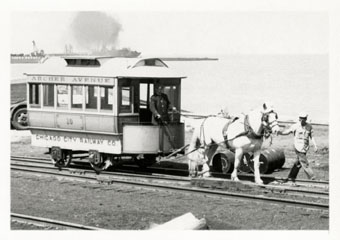

Above, Chicago City Railway #10 is a replica
car built by the Chicago City Railway at its
South Shops for the Chicago Museum of Science & Industry during 1929 and 1930, and
it appears to have featured at the Chicago World's Fair in 1933-34. It was intended to represent one of Chicago’s first horse cars
built in 1859. Designed for one-man operation with a single horse drawing it, the car weighs 4,560 lbs and is 16' 1½" long, 9' 9" tall and 7' ½" wide. Average speed would have been between 3-5 mph, with space for eighteen seated passengers.
In 2016, the car was sold at auction by the museum for $38,000.

Above, EMD FP7 #1602 was built in 1949, one of ten delivered to the Chicago & Eastern Illinois Railroad that year (#1600-#1609).
The FP7 formed part of EMD's
successful F series freight diesels, were designed for passenger service with steam generators fitted in an extended body. Three hundred and twenty-four were built from 1949 to 1953 for US railroads, and twenty-nine for Canadian railroads.
Originally numbered #327, this Atlantic type
(4-4-2) locomotive was one of five built in 1905 by Baldwin for the Chicago & Eastern Illinois
Railroad. It was renumbered #222 in 1911. With an engine wheelbase of 27’ 3” and driver wheelbase of 7’, #222 weighed 185,400 lbs, 101,550 lbs on its
78” drivers. The engine was equipped with Stephenson valve gear and had 21” x 26” cylinders. The grate was 47.7 sq ft, the firebox 181.06 sq ft. Total heating surface was 3,106 sq ft and, operating at a boiler pressure of 200 psi, it delivered 24,990 lbs tractive effort. The tender weighed 138000 lbs light and had a 7,500 gallon water and 12 ton coal capacity.
None of the CEI 4-4-2s have been preserved.


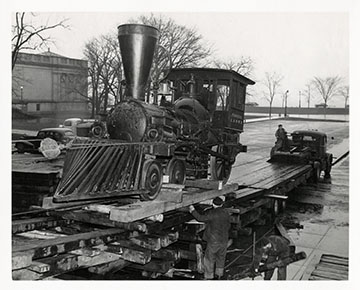
Above, the 4-2-0 “Pioneer” was built in 1837 by Baldwin for the Utica & Schenectady Railroad, NY, as #4 and named "Alert". Nine years later, it was sold to the Michigan Central Railroad who used it for two years before selling it to the Galena & Chicago Union Railroad, the oldest predecessor of what would become the Chicago & North Western Railway.
The “Pioneer” also appeared at the 1933-34 Chicago World’s Fair. It is on display at the Chicago History Museum. You can find out more about it on the CNW #4 page of this website.

Above left, #701 is an EMC NW1 built in 1938.
Below, Rock Island #5118 was one of twenty R-67b class Northern type (4-8-4) locomotives built by Alco for the railroad in 1944 (#5100-#5119). It had Walschaert valve gear, 26” x 32” cylinders, Boxpok drivers and roller bearings on all axles. With an engine wheelbase of 47’ 1” and driver wheelbase of 19’ 9”, #5118 weighed 467,000 lbs, 280,000 lbs on its 74” drivers. The grate was 96.3 sq ft and the 578 sq ft firebox included four thermic syphons totalling 155 sq ft. Total heating surface was 6,011 sq ft, including 1,438 sq ft superheating.
Above, #801 is a Ten Wheeler type (4-6-0) locomotive built in 1906 by Burnham, Williams & Co., an early incarnation of the Baldwin Locomotive Works in Philadelphia, PA, as Warren & Ouachita Valley Railway #1. It was the only steam locomotive owned by the company. #1 was sold to the Chicago, Rock Island & Pacific Railroad in 1949. Renumbered #801, it participated in the “Wheels A-Rolling” pageant. In 1952, it was renumbered #19 when a Baldwin-built switcher took the number #801.
#801 has been restored to its original Warren & Ouachita Valley Railway livery and number. You can see photos and find out more about it on the Warren & Ouachita Valley #1 page of this website.

"Stourbridge Lion" was the first steam engine to run on a commercial railroad in the US.
It was built by Foster, Rastrick and Company in Stourbridge, England.
In preparation for the 1933-34 Century of Progress Exposition, The Delaware & Hudson Railroad built a replica of the engine in its Colonie, NY, shops. After researching the most authentic reproduction, all the iron parts were hand-forged and the same care was applied to the rest of the locomotive. The replica was an anthracite-fuelled operating model. The replica also appeared at the 1939-40 New York World’s Fair.
You can see what remains of the original "Stourbridge Lion" on the Baltimore & Ohio Railroad Museum Roundhouse page of this website, and the replica itself on the "Stourbridge Lion" page.

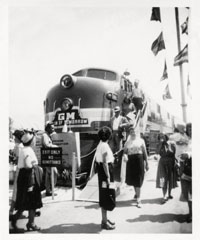
The medium blue four car Pullman Standard "Train of Tomorrow", including the first dome cars ever built, was hauled by EMD E7
#765.
The train began a 65,000 mile eighty-six city tour of the US and Canada on 26th May 1947 and spent much
of 1949 on display at the fair. It was intended to demonstrate the most modern passenger car construction techniques and nearly six million people walked through the train during its tour.
After the tour ended in
1950, the Union Pacific bought the equipment for
its pool service in the City
of Seattle, operating between Seattle, WA, and Portland, OR. #765 became UP #988 after the purchase, but has not been
preserved.

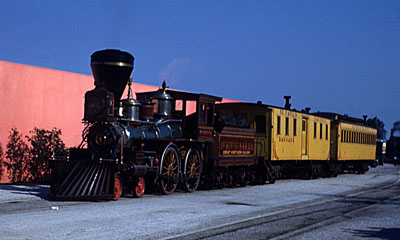

This locomotive was built in 1861 for the Minnesota & Pacific Railroad by the New Jersey Locomotive & Machine Works in Paterson, NJ. It was the first locomotive to operate in Minnesota, starting work in 1862 hauling passenger trains between St. Paul and St. Anthony. The M&P was absorbed into the St Paul & Pacific Railroad in 1879, and #1 was then named "William Crooks" after the Chief Mechanical Engineer of the railroad. In 1890, it passed to the Great Northern Railway with another transfer of the road. The locomotive also appeared at the Fair of the Iron Horse in 1927 and the New York World’s Fair in 1939-40.
The “William Crooks” has been preserved. You can see photos and find out more about it on the Lake Superior Railroad Museum page of this website.

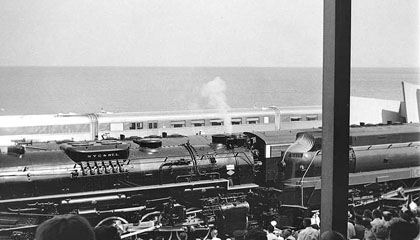
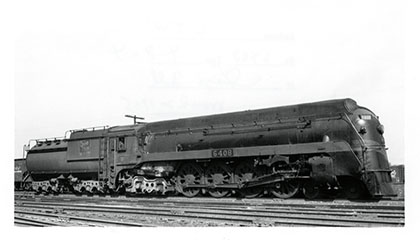
Top photo, on the right, Grand Trunk Western Northern
(4-8-4) type Class U-4-b #6408 in the "Wheels a-Rolling" pageant. The 4-8-4 was known as a "Confederation" by the GTW parent, Canadian National.
With a 44’ 1½” engine wheelbase and 20’ driver wheelbase, the engines weighed 382,700 lbs, 237,900 lbs on their 77” drivers. The cylinders were 24” x 30”, the grate was 73.6 sq ft and the 394 sq ft firebox included a combustion chamber and thermic syphons. Total heating surface was 5,382 sq ft including 1,530 superheating. Operating at a boiler pressure of 275 psi, they delivered 52,457 lbs tractive effort. The tender weighed 278,500 lbs light and had a capacity of 14,300 gallons of water and 20 tons of coal.
None of the U-4-bs has survived.



Built in 1880 by the Rogers Locomotive Works in Paterson, NJ, (later part of Alco) as #213, this Porter type (2-4-0) locomotive was one of a large fleet of engines acquired by the Illinois Central for short haul commuter traffic in the Chicago area. It was later renumbered #201 and hauled thousands of passengers to the 1893 Columbian Exposition in Chicago, at which time, John Luther Jones (aka "Casey Jones") may have been one of its engineers. #201 pulled the last IC steam commuter train when the line was electrified in 1926. The engine also appeared at the Chicago World's Fair in 1933-34 numbered #1401.
#201 has been preserved. You can see photos and find out more about the locomotive on the Illinois Railway Museum Train Shed page of this website.

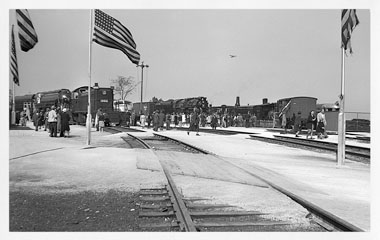
In the photo above, Lima-Hamilton LS-1000 #1000 is on the track on the right, just in front of the "Cincinnatian". The unit was displayed at the fair in 1949. It was one of three 1,000 hp demonstrator switchers built by Lima-Hamilton that year (#1000-#1002).
Thirty-eight LS-1000s were eventually built between 1949 and 1950. The units were 45' 10" long and weighed 240,900 lbs. With a 4-cycle Hamilton T89SA (8 cylinder) engine powering a Westinghouse WE499A generator to drive four Westinghouse WE362D traction motors, the LS-1000 delivered starting tractive effort of 60,000 lbs at 25% and continuous tractive effort of 34,000 lbs at 8.9 mph with a top speed of 60 mph.
Lima-Hamilton was formed in 1947 by the merger of the Lima Locomotive Works and the General Machinery Corporation of Hamilton, OH, but had short life. It produced just one hundred and seventy-four diesel locomotives before being merged into Baldwin-Lima-Hamilton in 1951.
#1000 was later sold to the Toledo, Peoria & Western with two other LS-1000 units and was renumbered #300. Only one LS-1000 has survived. ARMCO #709, in the collection of the Whitewater Valley Railroad in Connersville, IN, which was another of the three demonstrator models built in 1949, originally #1001.


Above, Michigan Central H10 #8000 was an experimental Mikado type (2-8-2) locomotive built by Lima. It appears to have hauled a consist of other locomotives, collectively part of the New York Central lines, to the fair, but does not appear to have featured as a display locomotive.
The H10 was the result of the efforts of William E. Woodard, Vice President and Chief Engineer of the
Lima Locomotive Works, to develop a more powerful
and more efficient steam locomotive than those in service during the early 1920s. The design evolved from ten Michigan Central class H7e 2-8-2s, built in 1920.
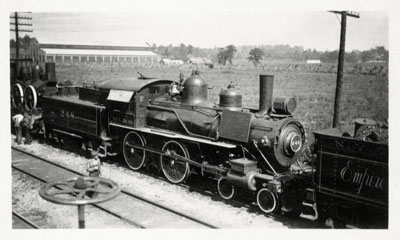
Above, also in the consist, #248. I have not been able to find out anything about this 4-4-0.

Above, Milwaukee Road Alco DL-109 #14A on display at the fair in 1948. The railroad introduced diesels on its famous Hiawatha trains in 1941 with the purchase of a back-to-back pair of DL-109s, #14A and #14B.
The DL-109 had two Alco 539T prime movers powering two GE GT-557 generators to drive four GE 730 traction motors. Weighing 345,000 lbs and 71' 6" long, it delivered starting tractive effort of 59,500 lbs at 25% and 25,100 lbs continuous tractive effort at 23 mph with a top speed of 120 mph.
Above, EP-3 is one of five electric locomotives (#10250–#10254) ordered from General Electric by the Milwaukee Road in 1919 for passenger services on the newly electrified Coast Division. It was powered by concealed storage batteries when on stage at the fair.
The locomotives operated on MILW's Coast Division from 1919 until 1957 and came to symbolise The Olympian, the railroad's premier passenger service between Chicago and Seattle. #10250 appeared at the Chicago World’s Fair in 1933-34. One EP-2 has survived, #10251 renumbered #E-2. You find out more about these locomotives on the National Museum of Transportation, St. Louis Yard page of this website.

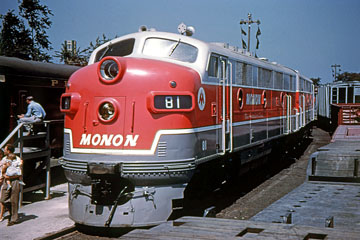
Above, another F3 unit built by General Motors Electro Motive Division at La Grange, IL. It was built in 1947 for the Chicago, Indianapolis & Louisville Railway, also known as the Monon Railroad. The Monon bought twenty-two F3 A units and five cabless B units that year and was one of the first Class I railroads to fully convert to diesel motive power in 1949.
The F3 was designed to haul heavy freight and had a Winton 567B 16 cylinder prime mover powering a GM-D12 generator to drive four GM-D17B traction motors, one on each axle. At 54' in length and weighing 258,000 lbs, they produced starting tractive effort of 55,000 lbs at 25% and 40,000 lbs continuous tractive effort at 9.3 mph. They had a top speed of 65 mph.
The #81-#84 A and B units were used on The Thoroughbred passenger service between Chicago, IL, and Louisville, KY, via Monon, IN. The train made its first run on 15th February 1948.
#81 has not survived, but you can see Delaware, Lackawanna & Western F3 #663 and #664, originally Boston & Albany #44 and #46, on the Scranton Yard page of this website as well as as ex-Boston & Maine F3B #4268B, and Chesapeake & Ohio F3Au #8016 on the North Carolina Transportation Museum page.



This American type (0-4-0) locomotive was built in 1855 by Rogers, Ketchum & Grosvenor in Paterson, NJ, (later part of Alco) to the Western & Atlantic's 5' gauge. It is one of the locomotives involved in what is known as the "Great Locomotive Chase". It appeared at the fair in 1948 courtesy of the Nashville, Chattanooga & St Louis Railway.
The “General” also appeared at the 1933-34 Chicago World’s Fair and the 1939-40 New York World’s Fair. You can see photos of the locomotive and find out more about it and the Great Locomotive Chase on the Southern Museum and Great Locomotive Chase page of this website.



#779 is an S-3 Class Berkshire type (2-8-4) locomotive built at a cost of $187,000 for the New York, Chicago & St. Louis Railroad, also known as the Nickel Plate, in May 1949, for use on fast
freight trains. It was one of a final order of ten Berkshires placed by the Nickel Plate Railroad (#770-#779), bringing their total roster of this type to eighty. It was also one of the last steam locomotives manufactured by the Lima
Locomotive Works. It went on display at the fair in 1949.
In May 1963, the locomotive was donated to the City of Lima, OH, and placed on display in Lincoln Park. You can see photos and find out more about it on the NKP #779 page of this website.


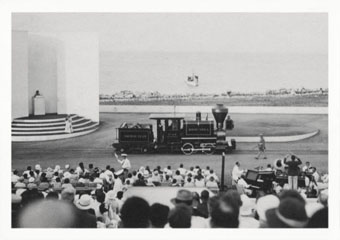
Northern Pacific #1, the “Minnetonka”, was built by Smith & Porter of Pittsburgh, PA, in 1870 for $6,000, and was the Northern Pacific's first locomotive and helped build the east end of the NP system. A wood burning 0-4-0T (Tank) locomotive weighing 28,270 lbs with 44" drivers and 10" x 16" cylinders, #1 is 17½' long. It operated at a boiler pressure of 125 psi delivering 3,330 lbs tractive effort.
The “Minnetonka” also appeared at the 1933-34 Chicago World’s Fair and 1939-40 New York World’s Fair. The engine has been preserved, and you can see photos and find out more about it on the Lake Superior Railroad Museum page of this website.

The New York Central & Hudson River Railroad unveiled this 4-4-0 American type locomotive, #999, in 1893 for display at the Columbian Exposition in Chicago, IL, where it was described as the "Fastest Locomotive in the World". Designed by the company's Chief Superintendent of Motive Power & Rolling Stock, William Buchanan, it was built at the railroad's West Albany, NY, shops at a cost of $13,000.
As well as the 1933-34 Chicago World’s Fair, #999 appeared at the New York World’s Fair in 1939-40. The engine has been preserved.
The "DeWitt Clinton" is a replica built in 1893 by the New York Central Railroad for display at that year's Columbia Exposition in Chicago, IL. The original was designed by John B. Jervis and built by David Matthew at the West Point Foundry in New York for the Mohawk & Hudson in 1831. It was the M&H's first locomotive, the first to operate in the state of New York and only the fourth steam locomotive built in the US.
The “DeWitt Clinton” was exhibited at the Fair of the Iron Horse in 1927, the 1933-34 Chicago World’s Fair and the 1939-40 New York World’s Fair. It has been preserved, and you can see photos and find out more about it on the Henry Ford Museum page of this website.
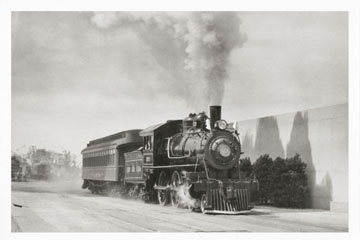
You can see it on the Chicago Museum of Science and Industry page of this website.


Built by Alco, #6007 was one of twenty-five S-1b Northern type (4-8-4) locomotives delivered to the New York Central between late 1945 and early 1946 (#6001-#6025). The 4-8-4 was dubbed a “Niagara” on the NYC.
These were considered amongst the most efficient 4-8-4s ever built, with integrally cast, one-piece frames and cylinders, and roller bearings on all axles and side rods. The Baker valve gear had no sliding surfaces and was fitted with needle bearings. The seven axle pedestal tender weighed 337,000 lbs light with a capacity of 46 tons of coal and 18,000 gallons of water. Retirements occurred in 1955 and 1956. None of the NYC Niagaras has survived.
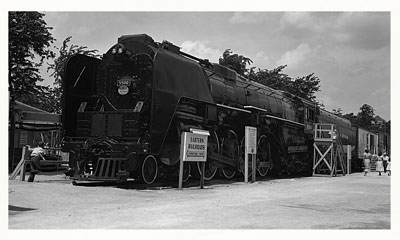
Built by Alco at its Schenectady, NY, works in June 1946, Class S-2a #5500 was the twenty-sixth Northern (4-8-4) type, or "Niagara", as they were known on the New York Central, and the last steam locomotive bought by the railroad. It was an experimental unit with Franklin-Caprotti poppet valves instead of the Baker valve gear and piston valves that had been fitted to the other twenty-five NYC Niagaras (#6001-#6025).
In tests, #5500 proved more powerful than the rest of the Central’s Niagaras, but also burned 15% less fuel per horsepower. After testing, the engine was assigned to the same duties as the rest of the 4-8-4s, including fast freight and passenger service. The Niagaras had a small water capacity (18,000 gallons) in the tender, because
the New York Central was one of the few in North America which used track pans. This allowed a larger coal capacity of 46 tons so that the New York, NY, to Chicago, IL, run could be done with only a single stop to re-coal at Wayneport, NY, fourteen miles east of Rochester.
With its poppet valves, however, it presented some maintenance problems and it was decided to retire #5500 in 1951 after only five years in service. The locomotive was then used to supply parts to the rest of the New York Central’s 4-8-4 fleet and the remains of #5500 were sold for scrap in 1956. The remaining twenty-five Niagaras were retired between 1955 and 1956 and all were scrapped soon after.

The replica “John Bull” has been preserved and you can find out more about the engine on the Pennsylvania Railroad Museum Train Shed page of this website.
The home of the original "John Bull", the Camden & Amboy Railroad, was absorbed by the Pennsy in 1871 but, seeing the publicity opportunity of owning the oldest steam locomotive in the US, the railroad displayed "John Bull" at various fairs and expositions until gifting it to the Smithsonian in Washington DC in 1884. It was last fired up in 1981 on its 150th birthday.
This replica of the "John Bull" was built at the Pennsylvania Railroad’s Altoona, PA, Workshops in 1939 to debut in 1940 at the New York World’s Fair. Other than a modern welded boiler and the addition of a small injector, the replica exactly reproduced the original, which was built in 1831 by Robert Stephenson & Co., of Newcastle in the United Kingdom and then shipped in parts to Philadelphia to work on the Camden & Amboy Railroad.
The locomotive was built as an 0-4-0 type, but a leading truck was added to assist road holding. As a result, the connecting rods had to be disconnected, leaving the rear axle as the sole driving wheel.
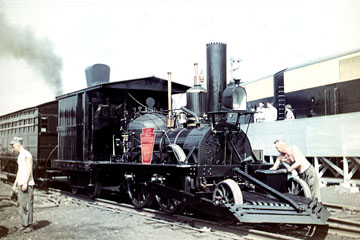
You can see the original “John Bull” on the Smithsonian page of this webste.
The engine weighs 112,000 lbs and has a driver wheelbase of 18’ 5” with 20” x 24” cylinders, a 15.75 sq ft grate and 116 sq ft firebox and total heating surface of 1,378 sq ft. Operating at a boiler pressure of 100 psi, it delivered 16,653 lbs tractive effort. The two water tanks on either side of the engine have a total capacity of 1,800 gallons of water and the rear bunker holds 3 tons of coal.
In 1968, the locomotive went on display at the Children's Museum of Indianapolis where it has remained ever since. The museum is at 3000 N Meridian St.
The “Reuben Wells” is an 0-10-0T (Tank) locomotive constructed by the Jeffersonville, Madison & Indianapolis Railroad in 1868 to operate over a two mile stretch of track with a 5.89% grade on Madison Hill, IN. At the time it was built, it was the most powerful locomotive in the world. The railroad had first used various methods to get train cars up the hill including horses and rack and pinion locomotives.
The "Reuben Wells" was retired in 1898 but stayed in reserve until sent to Purdue University in 1905.

You can see photos of the engine on the JMI #35 page of this website.
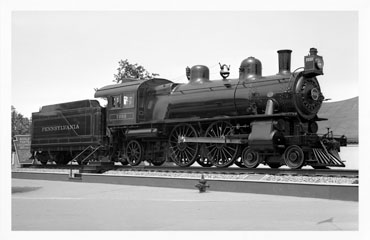
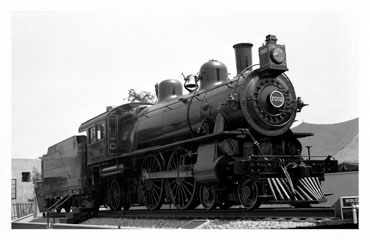
Built in 1902 by the Pennsylvania Railroad as
#8063, an E2a class Atlantic (4-4-2) type, this locomotive was later converted to an E7s and renumbered #7002. It then represented the locomotive that had set a 127.1 mph steam locomotive speed record in 1905 between AY
Tower and Elida, OH, on 12th June 1905 on its inaugural New York to Chicago run hauling the Broadway Limited. However, that locomotive,
which was also built in 1902, had been scrapped in 1934.
#7002 also appeared at the 1939-40 New York World’s Fair. It has been preserved and you can find out more about it on the Pennsylvania Railroad Museum Train Shed page of this website.
Left Pennsylvania Railroad GG-1 #4912.
It is one of one hundred and thirty-nine of the class built at the Pennsy's Altoona, PA, shops between 1934 and 1943 designed to operate over the railroad’s electric line between Washington, DC, and New York City.
Right and below, PRR GG-1 #4926 also appeared at the fair. It was built in 1942.
Twelve 385 hp GEA-627-A1 traction motors drove the six 57" driving wheels. Each motor developed 385 hp giving a total of 4,620 hp. GG1s could accelerate from 0 to 100 mph within 65 seconds and, at that speed, delivered 65,500 lbs tractive effort.
The GG1s were very good at hauling heavy
loads, largely because of a strong steel frame
with added weight from concrete to facilitate traction. As the GG1 was designed to haul passenger trains, it also has a boiler that burned oil to produce steam to heat the passenger cars.
A number of GG-1s have survived. You can see the first of the type, #4800 “Old Rivets”, on the Pennsylvania Railroad Museum Yard page of this website. There are other examples on the Pennsylvania Railroad Museum Train Shed, the New York Central Museum page, National Railroad Museum, Museum of the American Railroad, Virginia Museum of Transportation and the Illinois Railway Museum Train Shed pages.
The T-1s had a rigid wheelbase with two sets of four axles each driven by a pair of cylinders.
The theory behind the duplex drive was that, by reducing the masses of reciprocating and
revolving parts, hammering would be reduced and higher speeds could be achieved. However, the T-1s were prone to violent wheelslip when starting and at speed and were expensive to run. Wheelslips at speed could also damage the Franklin poppet valve gear, which was also relatively inaccessible, making maintenance difficult.
Above and below, another 1946 T-1, #5549.
The T1 was designed to run reliably at speeds of
up to 100 mph and it was even claimed that they had been run at 140 mph when making up time, making them among the fastest steam
locomotives ever built. Due to their complexity relative to other steam locomotive designs, T-1s were known to be difficult to maintain. The
Pennsy decided in 1948 to place diesel
locomotives on all its express passenger trains, spelling their demise after just ten years in
service.
Above, Pennsylvania Railroad Class T-1 #5502.
Two prototypes of the Pennsylvania Railroad’s
T-1, 4-4-4-4 duplex drive locomotives were built by the Baldwin Locomotive Works in Philadelphia,
PA, in 1942. The exterior streamlining was designed by Raymond Loewy. In 1945, twenty-five production T-1s were built at the Pennsy's
Altoona, PA, works (#5500-#5024). A further twenty-five were built by Baldwin in 1946 (#5525-#5549). The streamlining was slightly different on these fifty T-1s, with more rounded noses, and these were the last steam locomotives built for the Pennsy. These were the last steam locomotives built by the Pennsy and perhaps their most controversial.
Above, #5543, one of the twenty-five built by the Baldwin Locomotive Works with slightly different streamlining.
The T-1 had an engine wheelbase of 51’ 11” and driver wheelbase of 25’ 4”. The engine weighed 502,200 lbs, 279,910 lbs on its 80” drivers. With Walschaert valve gear, 19¾” x 26” cylinders, a 92 sq ft grate, 490 sq ft firebox and total heating surface of 5,639 sq ft, including 1,430 sq ft superheating, the locomotive operated at a boiler pressure of 300 psi, delivering 64,653 lbs tractive effort. The tender weighed 441,500 lbs light and had a capacity of 19,200 gallons of water and 42.6 tons of coal. They could easily pull 910 ton passenger trains at 100 mph.

Production of the Pennsylvania Railroad's single class S-2 #6200 steam turbine locomotive in 1944 was a collaboration between Westinghouse, Baldwin and the Pennsy. It was the only example built of the 6-8-6 wheel arrangement and the largest direct-drive turbine locomotive ever built.
#6200 weighed 589,920 lbs. Two turbines were fitted, one for forward travel and a smaller one for reversing at speeds up to 22 mph. It had a large boiler with a Belpaire firebox, 120 sq ft grate and long combustion chamber.
#6200 went into passenger service between Crestline, OH, and Chicago, IL. It was powerful, with good fuel economy at speed, producing tractive effort of 70,500 lbs, but was highly uneconomical at lower speed. The turbine used less steam than conventional locomotives above 30 mph but, below that, it consumed huge amounts of coal, which quickly reduced the boiler pressure from the rated 310 psi to as low as 85 psi. The increased use of fuel at low speeds then caused the firebox to run hotter, sometimes causing stay bolts to break. Turbine maintenance was also a problem.
These problems and the evident advantages of diesel locomotives at this time meant the S-2 had a comparatively short life. It was taken out of service in 1949 and scrapped in 1952.


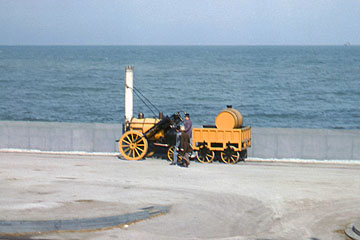
This replica of the "Rocket" is probably the one that was built in 1931 by Robert Stephenson & Co., in Darlington, England and in the collection of the Museum of Science and Industry.
The original 0-2-2 "Rocket" won Stephenson £500 at the Rainhill trials, a competition by the
Liverpool & Manchester Railway to determine the best motive power to employ on the railroad. Ten locomotives were entered, but only five
competed. The "Rocket" was the only one to complete the three day trials, starting on 6th October 1829, over which it averaged 12 mph and achieved a top speed of 30 mph. This replica "Rocket" is on the Museum of Science and Industry page of this website.

The engine was disassembled and shipped by boat to Charleston, SC, in October and made its inaugural run on Christmas Day that year.
On 17th June 1831, the locomotive became the first steam locomotive in the US to suffer a boiler explosion, apparently caused by the fireman tying down the steam pressure release valve.
This is a replica built by the Southern Railway in 1928 of the first steam engine built entirely in the US.
The replica 0-4-0 was constructed to commemorate the centenary of formation of the South Carolina Canal & Rail Road for which the original “Best Friend” had been built by the West Point Foundry in New York in 1830.
Salvageable parts from the locomotive were then used to build the South Carolina Canal & Rail Road’s “Phoenix”, another 0-4-0.
The replica “Best Friend” also
appeared at the 1939-40 New York World’s Fair and has been preserved with its replica coaches. It is on display in Charleston, SC, and you can see photos and find out more about it on the Best Friend of Charleston page of this website.
You can also see another full-size replica on display in Columbia, SC, on the Best Friend of Charleston South Carolina State Museum page.

Above and below, yet another EMD F3, Union Pacific #1449. It was fresh from delivery by the builder's La Grange, IL, works when displayed at the fair in July 1948.
One thousand, one hundred and eleven F3 A units were outshopped from EMD's La Grange, IL, works between 1945 and 1949, and six hundred and ninety-six B units. An early convert to the benefits of dieselisation, the Union Pacific became the owner of the largest fleet of F3 units in the US, buying eighty-nine F3 A units and ninety B units between 1947 and 1953.
Above Union Pacific 4-8-8-4 #4222. The twenty-five 4-8-8-4 Big Boys (#4000-#4024) built by Alco between 1941 and 1944 were the last steam locomotives delivered to the Union Pacific. Weighing 762,000 lbs, measuring 132' 10" from front coupler to rear tender coupler and delivering 135,370 lbs tractive effort. and were arguably the largest steam locomotives built in the US.
A number of Big Boys have survived and you can see photos of more of the class on the Kenefick Park, Steamtown, Southern California RLHS, Cheyenne Big Boy, National Museum of Transportation, St. Louis Yard and National Railroad Museum pages of this website.
The A units were usually coupled with one B unit but, occasionally, they were coupled into A-B-B-A sets to provide 6,000 hp of hauling effort. This appears to be the configuration in the slide above and the other A-B unit may be F3 #1457, which also appeared at the fair
Between 1952 and 1954, the 1400 class F3s that hadn't been reassigned to the Northwest Division in 1950 were converted internally to F7s by the UP's shop forces by installing a 567BC engine in place of the original 567B, and updating the electrical components. Many also received F7-type dynamic braking. #1449 was traded back to EMD by the UP in 1964 for newer power.
Above, in the Union Pacific exhibition
space a miniature streamliner provided free rides for the children.
The Union Pacific exhibit also included the original Golden Spike, driven into the rails at Promontory, UT, on completion of the transcontinental railroad on 10th May 1869.


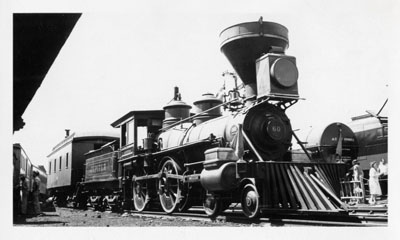
Above, Virginia & Truckee #12 “Genoa” was liveried as Central Pacific "Jupiter" for the re-enactment of the 1869 driving of the Golden Spike at Promontory, UT for the “Wheels A-Rolling” pageant. The American type (4-4-0) locomotive was built by M. Baird & Co., an early incarnation of the Baldwin Locomotive Works, in 1872 at a cost of $14,000. It also appeared in the "Railroads on Parade" pageant at the New York World’s Fair in 1939-40. It is one of the oldest operable steam locomotives in the US.
#12 has been preserved and you can see photos and find out more about it on the California State Railroad Museum page of this website. You can find out more about the Golden Spike ceremony on the Golden Spike NHS page of this website.
Above, below and top right, #21 is a 2-4-0 locomotive built by Baldwin in 1875 and originally named after the Virginia & Truckee's Master Mechanic, J. W. Bowker but, when the railroad stopped naming locomotives after employees or shareholders, it was renamed “Mexico”. worked as a switcher in Virginia City and around the Comstock's mines. It passed through a couple of owners after being sold in 1896 until, in 1937, it was presented to the Railway & Locomotive Historic Society for preservation.
#21 also appeared at the 1939-40 New York World's
Fair.
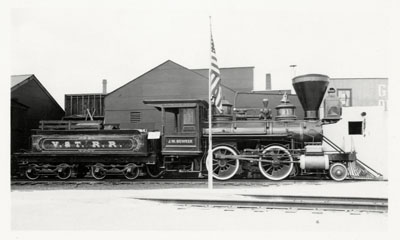
You can find out more about #21 on the California State Railroad Museum page of this website.
Lower photo above, this Virginia & Truckee American type (4-4-0) locomotive was liveried as Union Pacific #18 for the fair.
It was built in 1873 at the Central Pacific's shops in Sacramento, CA, as the "Dayton". In 1905, it was numbered #18. Acquired by Paramount Pictures Inc., for $1,000 in 1938, for the next nineteen years it made frequent appearances in movies beginning with Union Pacific. It spent much of the 1970s at Promontory, UT, participating in ceremonies for the centennial of the Golden Spike.
#18 has been preserved and is on display at the Comstock Center in Virginia City, NV.



At least four German 2-10-0 steam locomotives were brought to the US after WWII and tested at Fort Eustis. Class L-42 #42 1597 above appeared at the fair.
A coal burner weighing 342,400 lbs, this freight service locomotive was manufactured by Henschel & Sohn, Kassel, Germany, in 1944, representing the latest type of German war locomotive. It has Walschaert valve gear and, operating at 227 psi, it delivered 56,000 lbs tractive effort with a top speed of 50 mph.
All four German locomotives were scrapped during the 1950s, but three of the class have been preserved in Germany.
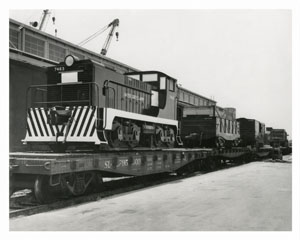
Above, model diesel engine #7463 and a short consist of box car, gondola, flat car and caboose loaded aboard flat cars for transportation to the fair. The headlight suggest it may have been based on the Baldwin VO-1000, but it has a much lower hood and shorter body. It was owned by the San Francisco Port of Embarkation and was built in the Fort Motor Vehicle Shops in Oakland, CA.
Below, RSD-1 #8674, a 1,000 hp diesel electric switcher built by Alco in 1945.
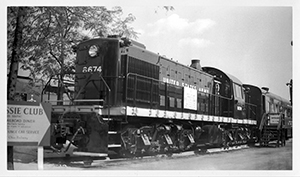
A number of S-2s have survived. You can see some on the National Railroad Museum, the National Museum of Transportation, St. Louis Yard and the Gold Coast Railroad Museum pages of this website.


The replica “Rogers” was built at the Wabash Railroad’s Decatur, IL, works in 1948 for the Railroad Fair.
The original "Rogers" was the fourth locomotive built by Rogers, Ketchum and Grosvenor in Newark, NJ, later the Rogers Locomotive Works and, later still, part of Alco. It was shipped in pieces to Meredosia by riverboat, accompanied by the engineer who was in charge of assembling it. The engine had a short life, however, retiring in 1844 and it was later scrapped.

The "Rogers" has not been preserved.


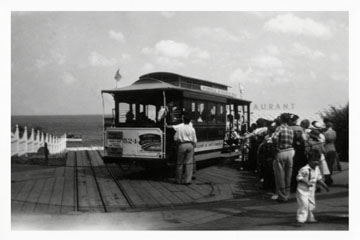
In 1949, the Western Pacific Railroad sponsored the appearance of San Francisco Powell Street cable car #524 at the fair. Two Powell gripmen and one from the California Street Cable Railroad accompanied #524. They were chosen for the honor by winning a bell ringing contest, the first of what would become a popular annual event.
524 was built by Mahoney Brothers in 1887 for the Ferries and Cliff House Railway. It was combined as MSRy in August 1893 and was numbered 534. MSR was taken over by URR in March 1902 and reorganized as a new MSRy in April 1921. It was rebuilt as 524 in 1929 and taken over by Muni in April 1944. It was rebuilt in 1958 and renumbered 24 in 1973. It still operates in San Francisco.

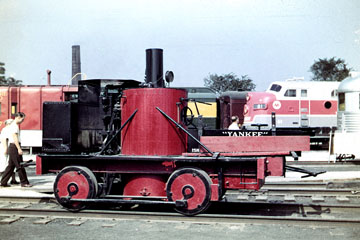
The "Yankee", above, a standard gauge 0-4-0 tank engine was built by the Cuyahoga Steam Furnace Company of Cleveland, OH. The company built iron equipment for saw mills, steamboats and iron furnaces and began steam locomotive building in 1850 with its first locomotive, the "Cleveland". In all, it built about one hundred locomotives.
The Jackson Iron Company bought the locomotive new between 1862 and1868 for use switching ore and other bulk material cars at their iron ore "Jackson Mine", at Negaunee in the Upper Peninsula of Michigan. In about 1889, the locomotive was retired to a scrap dump, where it survived until 1938 when it was cosmetically restored for display by Jackson's successor, the Cleveland-Cliffs Iron Company. In 1986, Cleveland-Cliffs donated it to the Michigan Iron Industry Museum at Negaunee, where it is now on permanent display.
The engine features an unusual design, with a centrally mounted vertical boiler extending well below the frame to just above the roadbed. Two vertically mounted marine type steam cylinders powered the gearing system directly attached to one of the locomotive's two axles. Power was transmitted from this axle to the the other with side-rods attached to the outboard side of each driver.


Also at the fair in 1949 was the car donated to the state of Illinois by the French people as part of the “Merci Train” (Thank You Train).
In the winter of 1947-48, the US began a relief effort to war-torn France and Italy: citizens donated more than seven hundred box cars of goods, food and clothing to an “American Friendship Train”. In gratitude, a group of French citizens organised a private effort to thank the people of the US for their assistance in the two world wars and for the relief aid. The result was the forty-nine box car “Merci Train”, one box car destined for each of the then forty-eight states, and one to be shared between the District of Columbia, Alaska and Hawaii.
Donations came from over six million French citizens. The steamship Magellan transported the box cars, which contained artwork, antiques and books to the US. The 250 ton train arrived in New York on 3rd February 1949 bearing a banner reading "MERCI AMERICA" with over 25,000 onlookers in attendance.
You can see other "40 et 8" cars on the Nevada State Railroad Museum page of this website, the Kentucky Railway Museum page, the Baltimore & Ohio Railroad Museum Roundhouse page, the Nevada State Railroad Museum page and Union Station, Ogden page.

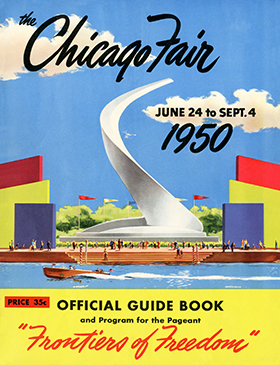
The site hosted the 1950 Chicago Fair where a number of engines appeared:
ATSF #5
BO "Atlantic"
BO "Lafayette"
BO "Pioneer"
BO "Tom Thumb"
BO "William Mason"
CBQ #637
CNW "Pioneer"
CP "Jupiter"
CS #9
DH "DeWitt Clinton"
GM #1950
GN "William Crooks"
NP "Minnetonka"
PRR "John Bull"
PRR "Pioneer"
PRR "Reuben Wells"
The "Rocket"
SOU "Best Friend of Charleston"
UP #119



